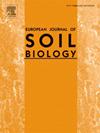在中欧黑钙土中与丛枝菌根真菌孢子密切相关的多功能内生细菌
IF 3.3
2区 农林科学
Q1 ECOLOGY
引用次数: 0
摘要
黑钙土是世界上最肥沃的土壤之一。在这种土壤上进行了长期的田间试验,发现丛枝菌根真菌(AMF)的孢子密度和物种丰富度出乎意料地高。本研究的目的是通过在高肥力钙质黑钙土上进行的长期田间试验,估计选定的AMF物种孢子内的细菌群落,以揭示它们属于不同属和物种的多样性。我们假设黑钙土中AMF物种丰富度高反映在原生细菌组成介导的多种功能特征的细菌多样性上。选择的AMF种有:mossefuneliformis、calospora Scutellospora和Septoglomus nigrum,因为它们在减量耕作和常规耕作制度中都大量存在。对分离菌株的纯培养物进行了磷增溶、铁载体产量、吲哚-3-乙酸产量和1-氨基环丙烷-1-羧酸脱氨酶活性等生态功能(性状)的测试。此外,还评估了其对半生物营养和坏死性真菌及卵菌的抑菌活性。大多数菌株只与三种AMF中的一种相关,因此,证据表明每种AMF可能都有自己的细菌群落。大量的细菌群落被证明具有多种功能,从植物生长促进性状到抗菌活性。这些发现表明,与AMF密切相关的细菌的多功能性可以显着扩展本地AMF种群的生态功能,并使寄主植物能够探索应对不断变化的环境条件的强大方法。本文章由计算机程序翻译,如有差异,请以英文原文为准。
Multifunctional endophytic bacteria intimately associated within spores of arbuscular mycorrhizal fungi in a chernozem soil in Central Europe
Chernozems are counted among the most fertile soils worldwide. Unexpectedly high spore density and species richness of arbuscular mycorrhizal fungi (AMF) were found in a long-term field trial established on such a soil. The purpose of the present study was to estimate bacterial communities associated within spores of selected AMF species from a long-term field trial on a highly fertile Calcic Chernozem to unravel their diversity belonging to different genera and species. We hypothized that high AMF species richness found in the Chernozem soil is reflected in a bacterial diversity with multifunctional traits mediated by indigenous bacterial compositions. The AMF species Funneliformis mosseae, Scutellospora calospora and Septoglomus nigrum were selected, since they occurred abundantly both in reduced and conventional tillage systems. The pure cultures of isolated bacterial strains were tested for ecological functions (traits) such as phosphorus solubilization, siderophore production, indole-3-acetic acid production and 1-aminocyclopropane-1-carboxylate deaminase activity. In addition, antimicrobial activity against both hemibiotrophic and necrotrophic fungi and oomycetes was evaluated. The majority of bacterial strains was exclusively associated with only one of the three AMF species, thus, giving evidence that each AMF species may harbor its own bacterial community. A large number of bacterial communities was shown to exert multifunctional activities ranging from plant growth promotion traits to antimicrobial activity. These findings suggest that the multifunctionality of bacteria intimately associated with AMF could markedly expand the ecological function of an autochthonous AMF population and empower host plants to explore robust ways to cope with changing environmental conditions.
求助全文
通过发布文献求助,成功后即可免费获取论文全文。
去求助
来源期刊

European Journal of Soil Biology
环境科学-生态学
CiteScore
6.90
自引率
0.00%
发文量
51
审稿时长
27 days
期刊介绍:
The European Journal of Soil Biology covers all aspects of soil biology which deal with microbial and faunal ecology and activity in soils, as well as natural ecosystems or biomes connected to ecological interests: biodiversity, biological conservation, adaptation, impact of global changes on soil biodiversity and ecosystem functioning and effects and fate of pollutants as influenced by soil organisms. Different levels in ecosystem structure are taken into account: individuals, populations, communities and ecosystems themselves. At each level, different disciplinary approaches are welcomed: molecular biology, genetics, ecophysiology, ecology, biogeography and landscape ecology.
 求助内容:
求助内容: 应助结果提醒方式:
应助结果提醒方式:


